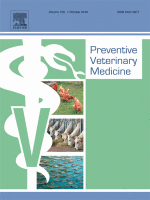Epidemiology of Mycobacterium bovis and Mycobacterium tuberculosis in animals: Transmission dynamics and control challenges of zoonotic TB in Ethiopia

Citation: Gebremedhin Romha, Gebreyohans Gebru, Abrha Asefa, Gezahegne Mamo. Epidemiology of Mycobacterium bovis and Mycobacterium tuberculosis in animals: Transmission dynamics and control challenges of zoonotic TB in Ethiopia. Preventive Veterinary Medicine. Volume 158, 2018, Pages 1-17, ISSN 0167-5877. https://doi.org/10.1016/j.prevetmed.2018.06.012.
Abstract: Mycobacterium tuberculosis complex is the cause of tuberculosis (TB) in humans and other animals. Specifically, Mycobacterium bovis (M. bovis) and Mycobacterium tuberculosis (M. tuberculosis) are highly pathogenic mycobacteria that may infect different animal species and are the sources of TB in humans. The objective of this paper was to review the epidemiology of M. bovis and M. tuberculosis in animals. The review also highlighted the transmission dynamics of M. bovis and M. tuberculosis in humans and animals and control challenges of zoonotic TB in Ethiopia. The literature review focused on scientific peer-reviewed articles from studies exclusively conducted in Ethiopia that were published from 1998 to 2017. Husbandry system, breed and herd size have significant role in the epidemiology of bovine tuberculosis (BTB) in Ethiopia. The information presented reveals that different strains of M. bovis are widely distributed in domestic animals predominantly in the Ethiopian cattle and the main strain was found to be SB1176. In addition, the isolation of M. tuberculosis from domestic animals in different settings signifies the circulation of the agent between humans and animals in Ethiopia. The life styles of the Ethiopian communities, close contact with domestic animals and/or the habit of consuming raw animal products, are suggested as the main factors for transmission of M. bovis and M. tuberculosis between human and animal which may have impact on the TB control program in human. In Ethiopia, a human TB control program has been widely implemented, however, the role of animal in the transmission of the causative agent has been neglected which could be one of the challenges for an effective control program. This warrants the need for incorporating animal TB control programs using “One Health” approach for effective TB control for both human and animal.
Author(s): Preventive Veterinary Medicine
Year: 2018
Language: English
Region(s): ETHIOPIA
Resource Type: Journal Articles
Source: Other
Filed under: Epidemiology, Ethiopia, Journal Article, One Health, Research, TB control, Transmission, Zoonotic
